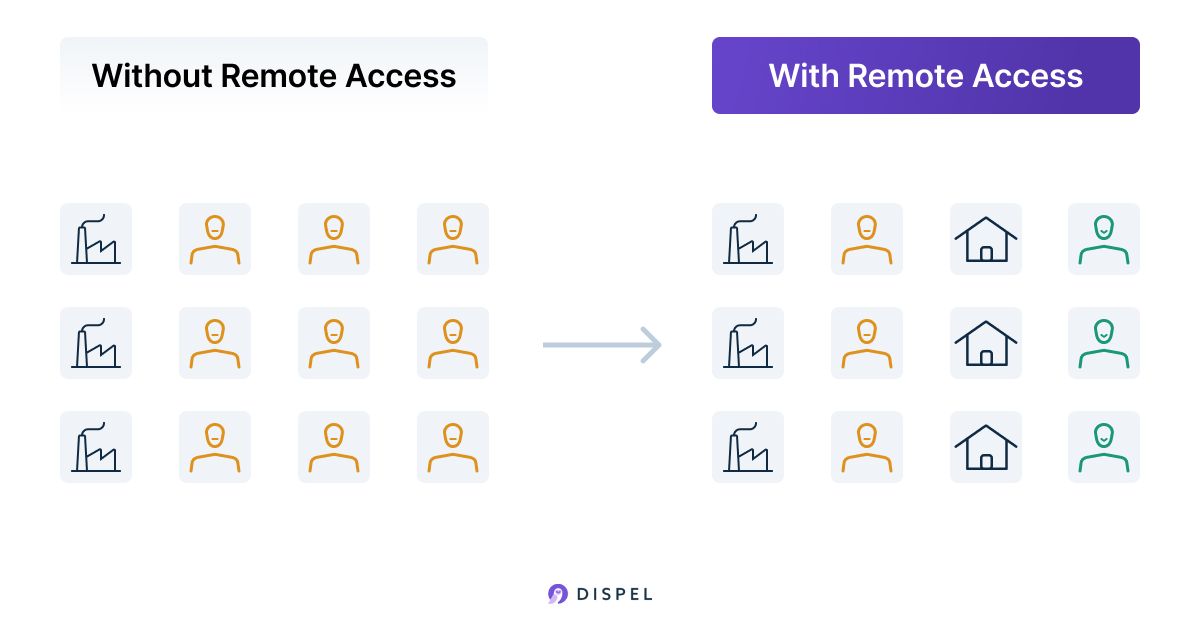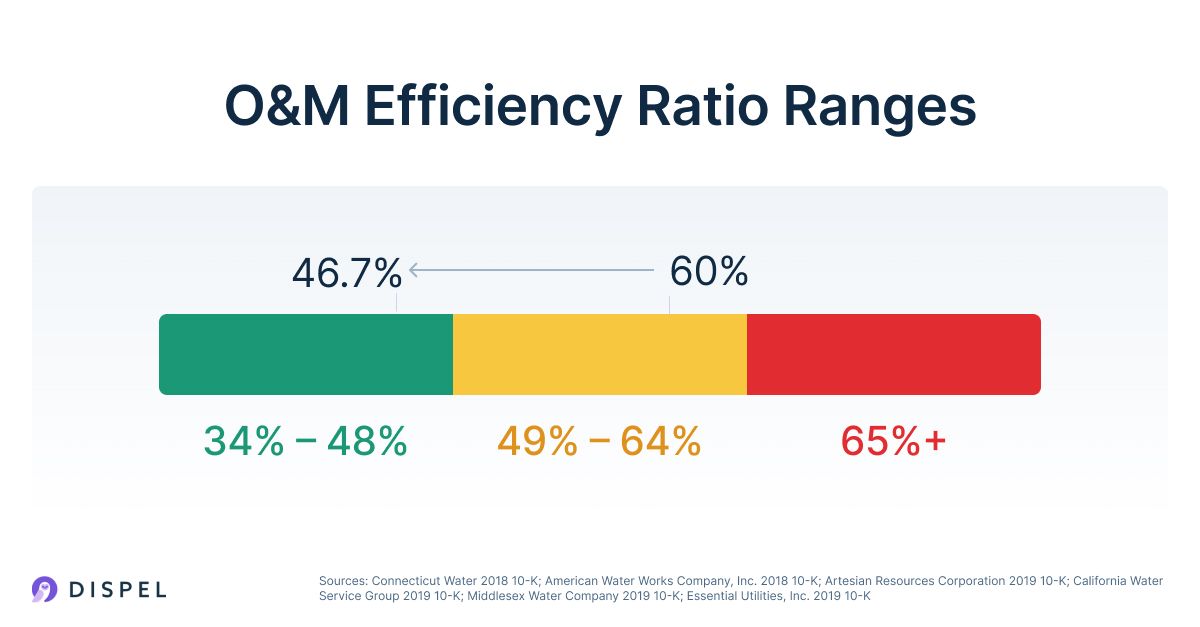Water and wastewater utilities in the United States rely on aging, legacy infrastructure. For these systems to operate efficiently, and optimally navigate an increasingly remote work landscape, modernization with tools like industrial remote access has become a necessity. In this blog, we will examine how your utility can optimize efficiency by reducing hidden operations and maintenance costs, and how remote access can help to alleviate these expenses.
Why Are Expenses High for Water Utility Companies?
Most water and wastewater utilities in the United States spend a large portion of their operating revenue on employee labor costs, which represent part of operations and maintenance (O&M) expenses. In order to reduce overall O&M costs, let's unpack why labor costs are high in the first place.
At many utilities, an operator may need to tend to a pump for 20 minutes or 2 hours—but no one knows exactly when this might happen. As a result, teams of operators are needed on-site 24/7 to resolve problems as soon as they occur.
Another way to address on-site issues quickly, without carrying the costs of multiple 24/7 operators, is with ICS remote access. Industrial remote access allows your operators to address problems instantly—without requiring them to be physically present. By leveraging remote employees to consolidate your workforce, organizations can reduce the number of operators needed on-site 24/7. This, of course, leads to reduced spend on employee labor costs and lower operations and maintenance expenses.
The goal is not to eliminate 24/7 monitoring or presence entirely. Having a handful of operators on-site at all times may be a necessity for your organization. However, with remote access, a group of 2-3 people can more effectively tackle the work of 7-10 people. In this case, you are simply getting more out of fewer full-time employees, and improving their quality of life.
Representative Example: Industrial remote access reduced needed full-time employee burn by 33% and allowed 50% of the operating workforce to alternate shifts on-site and work from home.

How to Assess Your Operations and Maintenance Costs
An O&M efficiency ratio can help inform how much your operations and maintenance costs deduct from your operating revenue as a whole, and where your organization spends most of its operating revenue. The larger your O&M efficiency ratio, the more inefficient your utility, and the more strongly you might want to consider implementing an industrial remote access tool to help cut down on costs. Depending on how your organization measures operations and maintenance expenses, you might already calculate this ratio.
Here's how to calculate your O&M Efficiency Ratio:
Let's say your operating revenue totals $100,000, and your operations and maintenance expenses total $60,000.
The formula for calculating your O&M Efficiency Ratio is:
O&M Efficiency Ratio = Operations & Maintenance Expenses / Operating Revenue x 100

Let's plug the appropriate numbers in:

When collecting the appropriate numbers, you should determine how much employee labor costs factor into your operations and maintenance expenses. For the purposes of this example, let's say labor costs represent 67% of your O&M expenditures.

If you implement remote access and reduce your labor costs by 33%, for example, that translates to $13,333 of revenue saved, and reduces your O&M ratio by 13.3%. Your new O&M ratio would be calculated as:


Other Hidden Labor Costs to Look Out For
We already discussed how maintaining operators on-site 24/7 can raise your labor costs, but now let's look at how login time, travel time, and attracting and retaining a quality workforce can contribute to hidden employee labor expenses as well.
Login Time:
If you already have an industrial remote access system in place, then it might be worth evaluating your remote access tool's login time for both operators and 3rd party vendors. If your remote access tool takes between 10-15 minutes to log in, then you are wasting money on unnecessary labor costs due to inefficient logins. An efficient remote access tool should take less than 30 seconds to connect.
What are the potential costs of an inefficient login? If we distill the labor cost of an inefficient 12-minute login time, it comes out to $6,704* per team member per year. If there are 30 people on your team, this cost becomes $201,120 per year. By comparison, a 30-second login's yearly labor cost comes out to $279 per team member.
*Based on 4 daily logins at an hourly wage of $22.96/hr.
Travel Time:
If you don't already have a remote access tool in place, and you drive on-site to perform maintenance, your organization wastes money on travel time. Depending on how far away your employees live from the site they work at, travel time can cost you $8,380** per year per employee in just hourly wages. If you have 30 employees commuting to a site, travel time associated costs jump to $251,400.
** Based on an estimated 30 minute one-way travel time twice per day at an hourly wage of $22.96/hr.
Attracting and Retaining a Quality Workforce:
According to the EPA, roughly one-third of the water sector workforce will become eligible to retire in the next 10 years. An aging workforce means that water and wastewater plants will eventually become understaffed, which can lead to potential health and safety issues for the general public. If your utility has not already begun to consider ways to attract and retain workers, you will need to plan out how and where to spend money to prevent your facilities from becoming short-staffed.
Implementing industrial remote access makes the lives of operators easier, more efficient, and more attractive and modern to a younger generation of workers needed to fill these roles. Once the impending labor shortage reaches its full impact, remote access will help to ensure your plant’s uptime, availability, and crew safety with fewer workers.
Next Steps for Water Utility Companies
There are many reasons why the water industry might take steps toward modernization. For most, reducing costs serves as the primary motivating factor. Take the time to assess your operations and maintenance costs, and determine how much you spend on labor. For more information on remote access, please visit dispel.io/efficiency.
About Dispel
Dispel provides secure remote access designed for OT networks. Built on Moving Target Defense architecture, Dispel helps organizations enable OT remote access while staying aligned to regulatory frameworks and compliance standards. If you are looking to securely bring an OT network online, or harden existing Internet-accessible OT assets, schedule a demo at dispel.io/efficiency.
Sources:
https://twri.tamu.edu/publications/txh2o/2019/summer-2019/10-challenges-of-water-utilities/
https://www.awwa.org/Portals/0/AWWA/Development/Managers/2018_SOTWI_Report_Final_v3.pdf
https://www.waterworld.com/water-utility-management/article/16191335/iot-and-security-what-does-it-mean-for-the-water-industry
https://www.waterworld.com/water-utility-management/asset-management/article/14180524/lead-follow-or-get-out-of-the-way
https://www.epa.gov/sustainable-water-infrastructure/water-sector-workforce
https://www.sec.gov/Archives/edgar/data/1410636/000141063619000041/a12312018-awkx10kdocument.htm#s50653517819F57C99ED0FF06DAA2268D
https://www.sec.gov/Archives/edgar/data/863110/000086311020000009/form10k.htm#ITEM15
https://www.sec.gov/ix?doc=/Archives/edgar/data/66004/000117494720000248/msex10k2019.htm#t001
https://www.sec.gov/Archives/edgar/data/276209/000027620919000004/ctws2018form10-k.htm
https://www.sec.gov/ix?doc=/Archives/edgar/data/1035201/000103520120000002/cwt-12312019x10k.htm#sA787F91EB82E5C519D4B47C0636FB8AB
https://www.sec.gov/ix?doc=/Archives/edgar/data/78128/000007812820000005/wtrg-20191231x10k.htm
